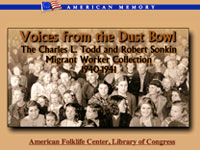People as Primary Sources: Conducting Interviews
The Bracero Archive which focuses on migrant workers in the 20th century, has a tutorial for conducting oral history interviews. The tutorial, a narrated PowerPoint presented in a video, provides a variety of information including general advice about setting the tone for the interview and what types of questions to ask, as well as technical advice about using recording equipment. Some of the information in the tutorial is specific to the Bracero Archive project, but most of it is general information that will help students conduct interviews; and as students develop an understanding of how to conduct interviews, they can also gain insights that will help them analyze other oral history interviews.
To watch the video, scroll to "Video Tutorials," then to "Conducting an oral history interview."
